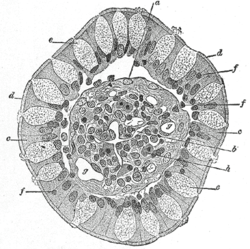Simple columnar epithelium
| Simple columnar epithelium | |
|---|---|
 | |
| Identifiers | |
| TH | H2.00.02.0.02020 |
| FMA | 45567 |
| This article is one of a series on |
| Epithelia |
|---|
| Squamous epithelial cell |
| Columnar epithelial cell |
| Cuboidal epithelial cell |
| Specialised epithelia |
|
| Other |
A simple columnar epithelium is a columnar epithelium that is uni-layered. In humans, a simple columnar epithelium lines most organs of the digestive tract including the stomach, small intestine, and large intestine. Simple columnar epithelia line the uterus.
Structure
Simple columnar epithelium is further divided into two categories: ciliated and non-ciliated.
Location
Non-ciliated types are found in the digestive tract. Ciliated types are found within bronchioles of the respiratory tract and in the oviduct of the female reproductive tract.
Ciliated
Ciliated columnar epithelium moves mucus and other substances via cilia and is found in the upper respiratory tract, the Fallopian tubes, the uterus, and the central part of the spinal cord.They are the primary target of infection for "common cold viruses" such as coronaviruses, influenza virus and rhinoviruses. These viruses may kill the ciliated cells or stop the cilia beating. In either case, mucus builds up and forms a good site for secondary bacterial infections, resulting in mucus.
A ciliated columnar epithelium lines the lumen of the uterine tube, where currents generated by the cilia propel the egg cell toward the uterus.
Non-cilitated
This is found lining sections of the gastrointestinal tract and may be brush bordered.

 Transverse section of a villus, from the human intestine. X 350.
Transverse section of a villus, from the human intestine. X 350.
a. Basement membrane, here somewhat shrunken away from the epithelium.
b. Lacteal.
c. Columnar epithelium.
d. Its striated border.
e. Goblet cells.
f. Leucocytes in epithelium.
f’. Leucocytes below epithelium.
g. Bloodvessels.
h. Muscle cells cut across.
References
External links
- Histology at KUMC epithel-epith05 "Gall bladder" - Simple columnar epithelium
- UIUC Histology Subject 1061 - Uterine tube lumen